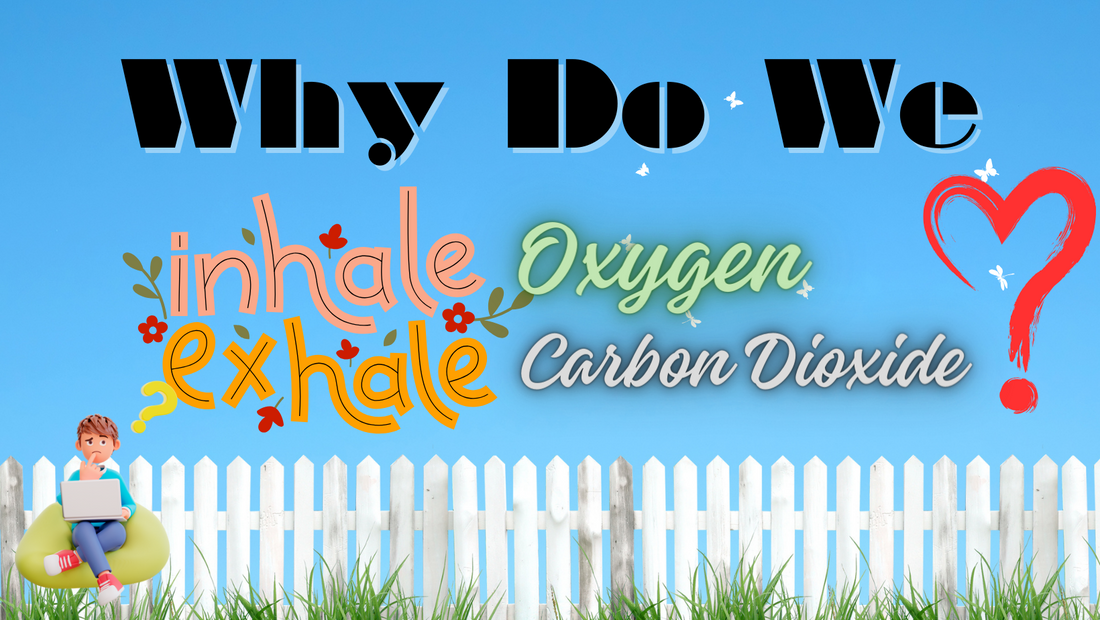
Why do we breathe in oxygen and breathe out carbon dioxide
Share
Understanding the Importance of Breathing: Why Do We Inhale Oxygen and Exhale Carbon Dioxide?
Introduction:
Breathing is a fundamental aspect of life, essential for the survival of all living organisms, including humans. But have you ever wondered why we breathe in oxygen and breathe out carbon dioxide? In this article, we'll delve into the intricate mechanisms of respiration, exploring the reasons behind this vital exchange of gases.
The Science Behind Breathing: Respiration is a complex biological process involving the exchange of gases between an organism and its environment. In humans, this process primarily occurs in the lungs. When we inhale, we take in oxygen-rich air, which travels down the respiratory tract and reaches the alveoli, tiny air sacs in the lungs where gas exchange occurs.
Oxygen (O2) from the inhaled air diffuses across the thin walls of the alveoli and into the surrounding capillaries, where it binds to hemoglobin molecules in red blood cells. This oxygenated blood is then transported throughout the body, delivering oxygen to cells and tissues to support various metabolic activities.
Conversely, as cells carry out metabolic processes, they produce carbon dioxide (CO2) as a waste product. This carbon dioxide is transported back to the lungs through the bloodstream. In the alveoli, carbon dioxide diffuses out of the capillaries and into the air within the lungs. When we exhale, we release this carbon dioxide-rich air back into the environment.
The Role of Oxygen in Cellular Respiration:
Oxygen plays a crucial role in cellular respiration, the process by which cells generate energy in the form of adenosine triphosphate (ATP) through the breakdown of glucose. Cellular respiration consists of three main stages: glycolysis, the citric acid cycle (also known as the Krebs cycle), and oxidative phosphorylation (electron transport chain).
During glycolysis, glucose is partially broken down in the cytoplasm of cells, producing pyruvate and a small amount of ATP. The pyruvate molecules then enter the mitochondria, where the citric acid cycle takes place. In this cycle, pyruvate is further broken down, releasing carbon dioxide as a byproduct and generating additional ATP.
The most significant ATP production occurs during oxidative phosphorylation, which occurs in the inner mitochondrial membrane. Here, oxygen serves as the final electron acceptor in the electron transport chain, allowing for the efficient production of ATP. Without an adequate supply of oxygen, cells cannot carry out oxidative phosphorylation efficiently, leading to decreased ATP production and cellular dysfunction.
The Importance of Carbon Dioxide Removal:
While oxygen is vital for cellular respiration and energy production, carbon dioxide is a waste product that must be removed from the body to maintain proper physiological function. Accumulation of carbon dioxide can lead to a decrease in blood pH, causing a condition known as respiratory acidosis.
In addition to its role in maintaining acid-base balance, carbon dioxide also plays a crucial role in regulating breathing. The concentration of carbon dioxide in the blood is one of the primary factors that influence respiratory rate and depth. When carbon dioxide levels rise, chemoreceptors in the brainstem detect this change and signal the respiratory muscles to increase breathing rate and depth, facilitating the removal of excess carbon dioxide from the body.
Furthermore, carbon dioxide also helps regulate blood flow to tissues by dilating blood vessels, ensuring that oxygen and nutrients are delivered efficiently to cells throughout the body.
Conclusion:
In summary, the exchange of gases during respiration is essential for maintaining homeostasis and sustaining life. We breathe in oxygen to support cellular respiration and energy production, while exhaling carbon dioxide helps remove waste products from the body and regulate breathing. Understanding the intricate mechanisms of respiration highlights the importance of maintaining proper gas exchange for overall health and well-being. So, the next time you take a deep breath, remember the vital role oxygen and carbon dioxide play in keeping you alive and thriving.
Gift One, Plant One Campaign
The Akalmand Gift Store philosophy is on "Gift one, plant one" or "Buy one, plant one" Campaign where We pledge plant trees with every product you buy.
By supporting this campaign and choosing our products, individuals can directly Plant more Trees in their happy moments like Birthday, Anniversary, Work Anniversary, Farewell, Reward & Recognition, Promotion, Celebration, Achievements and many other auspicious moments.
In conclusion, the number of trees a person is liable to plant on earth during their lifetime varies based on individual circumstances. However, everyone can contribute to planting more trees in one way or another, and every tree planted counts towards the global effort to combat climate change and preserve the environment.
Plant Trees, Save Environment, Create Healthy future for your Kids.
Dear Akalmands! Please support Gift One Plant One campaign by The Akalmand Gift.
Hindi Version of : Why Do We Inhale Oxygen and Exhale Carbon Dioxide?
सांस लेने का महत्व: हम क्यों ऑक्सीजन सांस लेते हैं और कार्बन डाइऑक्साइड बाहर निकालते हैं?
परिचय:
सांस लेना जीवन का एक महत्वपूर्ण पहलू है, जो सभी जीवित जीवों के जीवन के लिए आवश्यक है, जिसमें मानव भी शामिल हैं। लेकिन क्या आपने कभी सोचा है कि हम ऑक्सीजन सांस क्यों लेते हैं और कार्बन डाइऑक्साइड बाहर क्यों निकालते हैं? इस लेख में, हम सांस की जटिल तंत्रों को खोजेंगे, जो गैसों के इस महत्वपूर्ण आदान-प्रदान के पीछे के कारणों को अन्वेषित करेंगे।
सांस लेने के पीछे विज्ञान:
श्वसन एक जटिल जैविक प्रक्रिया है जो एक जीव के और उसके वातावरण के बीच गैसों के आदान-प्रदान को शामिल करती है। मानव में, यह प्रक्रिया प्रमुखतः पेशीयों में होती है। जब हम सांस लेते हैं, हम ऑक्सीजन युक्त हवा लेते हैं, जो श्वासनाली तक यात्रा करती है और फेफड़ों में जाती है, जहाँ गैसों का आदान-प्रदान होता है।
श्वासनालियों के दीर्घिक दीवारों से ऑक्सीजन (O2) अलविओली के आस-पासी कपिलेयों में अलग होता है, जहाँ यह लाल रक्त कोशिकाओं में हेमोग्लोबिन मोलेक्यूल में जुड़ता है। इस ऑक्सीजन से भरी हुई रक्त को शरीर के भिन्न-भिन्न कोशिकाओं और ऊतकों में ऑक्सीजन प्रदान करने के लिए पहुंचाया जाता है, जिससे विभिन्न उपावृत्तियों का समर्थन किया जा सकता है।
विपरीत रूप से, जैसे ही कोशिकाएं उपावृत्तियों को कार्यान्वित करती हैं, वे ग्लूकोज का विघटन करके कार्बन डाइऑक्साइड (सीओ2) को कृत्रिम अम्ल के रूप में उत्पन्न करती हैं। यह कार्बन डाइऑक्साइड रक्त प्रवाह के माध्यम से फिर फेफड़ों में लौटता है। अल्वेओली में, कार्बन डाइऑक्साइड कपिलेयों से बाहर और फेफड़ों के अंदर की हवा में बिखरता है। जब हम सांस छोड़ते हैं, तो हम इस कार्बन डाइऑक्साइड युक्त हवा को पुनः पर्यावरण में जारी करते हैं।
ऑक्सीजन का भूमिका कोशिकात्मक श्वसन में:
ऑक्सीजन कोशिकात्मक श्वसन में महत्वपूर्ण भूमिका निभाता है, जो कोशिकाओं में ग्लूकोज के विघटन के माध्यम से ऊर्जा उत्पन्न करता है। कोशिकात्मक श्वसन में तीन प्रमुख चरण होते हैं: ग्लाइकोलिसिस, सिट्रिक एसिड साइकिल (जिसे क्रेब्स साइकिल भी कहते हैं), और ऑक्सिडेटिव फोस्फोरिलेशन (इलेक्ट्रॉन परिवहन श्रृंखला)।
ग्लाइकोलिसिस के दौरान, कोशिकाओं के सायोप्लाज्म में ग्लूकोज आंशिक रूप से विघटित होता है, जिससे पायरूवेट और थोड़ी मात्रा में एटीपी उत्पन्न होता है। पायरूवेट मोलेक्यूल फिर मिटोकॉन्ड्रियों में प्रवेश करती हैं, जहाँ सिट्रिक एसिड साइकिल होता है। इस साइकिल में, पायरूवेट और थोड़ा कार्बन डाइऑक्साइड मुक्त होता है और अतिरिक्त एटीपी उत्पन्न होता है।
सबसे अधिक एटीपी उत्पन्नता ऑक्सिडेटिव फोस्फोरिलेशन के दौरान होती है, जो मिटोकॉन्ड्रिया की अंतर्निहित मेम्ब्रेन में होता है। यहाँ, ऑक्सीजन इलेक्ट्रॉन परिवहन श्रृंखला में अंतिम इलेक्ट्रॉन स्वीकारक के रूप में काम करता है, जिससे एटीपी का दक्षिणावर्त उत्पन्न हो सकता है। एटीपी के यथार्थ उत्पन्न के बिना, कोशिकाएं ऑक्सिडेटिव फोस्फोरिलेशन को प्रभावी रूप से कार्यान्वित नहीं कर सकतीं, जिससे एटीपी उत्पन्नता और कोशिकात्मक असमर्थता कम हो सकती है।
कार्बन डाइऑक्साइड हटाने का महत्व:
हालांकि ऑक्सीजन कोशिकात्मक श्वसन और ऊर्जा उत्पन्न करने के लिए महत्वपूर्ण है, कार्बन डाइऑक्साइड वह अपशिष्ट उत्पाद है जिसे शरीर से हटाना आवश्यक है ताकि सही भौतिकीय कार्य संचालित रह सके। कार्बन डाइऑक्साइड के एकत्रित होने की स्थिति से रक्त का pH कम हो सकता है, जिससे एक शर्त जो श्वसनिक अम्लावस्त्री कहलाती है, उत्पन्न होती है।
एसिड-आधार संतुलन को बनाए रखने के अलावा, कार्बन डाइऑक्साइड श्वासन को नियंत्रित करने में भी महत्वपूर्ण भूमिका निभाता है। रक्त में कार्बन डाइऑक्साइड का अधिकतम उपादान श्वासन दर और गहराई को प्रभावित करने वाले मुख्य कारकों में से एक होता है। जब कार्बन डाइऑक्साइड स्तर बढ़ता है, तो ब्रेनस्टेम में केमोरिसेप्टर्स इस परिवर्तन को जांचते हैं और श्वासनीय पेशियों को बढ़ाने और गहराई बढ़ाने के लिए संकेत करते हैं, जिससे शरीर से अतिरिक्त कार्बन डाइऑक्साइड को हटाया जा सकता है।
इसके अतिरिक्त, कार्बन डाइऑक्साइड ऊतकों के लिए रक्त प्रवाह को नियमित करने में भी महत्वपूर्ण भूमिका निभाता है, जिससे यह सुनिश्चित किया जाता है कि ऑक्सीजन और पोषक तत्वों को ऊतकों में प्रभावी ढंग से पहुंचाया जा सकता है।
निष्कर्ष: सांस आदान-प्रदान के द्वारा गैसों का अनुशंसा महत्वपूर्ण है, जो होमिओस्टेसिस को बनाए रखने और जीवन को धाराप्रवाह में रखने के लिए आवश्यक है। हम ऑक्सीजन को सांस लेते हैं ताकि पेशीय श्वसन और ऊर्जा उत्पन्न कर सकें, जबकि कार्बन डाइऑक्साइड को हटाने से अपशिष्ट उत्पादों को शरीर से हटाया जाता है और श्वासन को नियंत्रित किया जाता है। श्वासन की जटिल तंत्रों को समझना शरीर के सम्पूर्ण स्वास्थ्य और कल्याण के लिए सही गैस आदान-प्रदान को बनाए रखने की महत्वपूर्णता को उजागर करता है। तो, जब आप एक गहरी सांस लेते हैं, तो याद रखें कि ऑक्सीजन और कार्बन डाइऑक्साइड आपके जीवन और स्वस्थ रहने के लिए कितना महत्वपूर्ण है।









